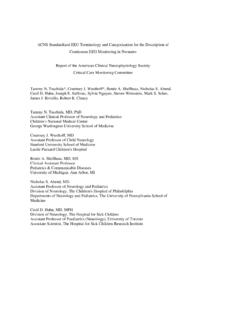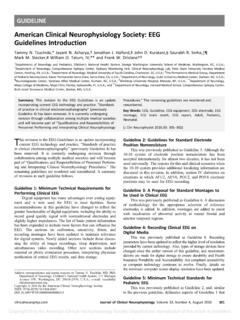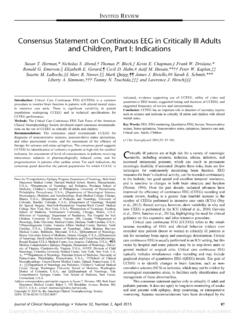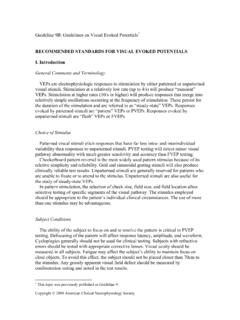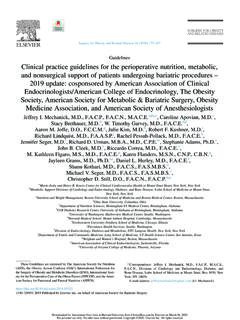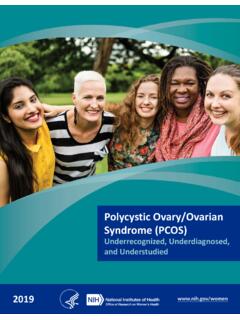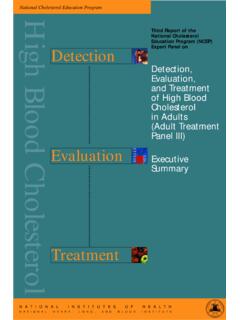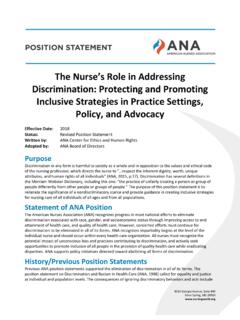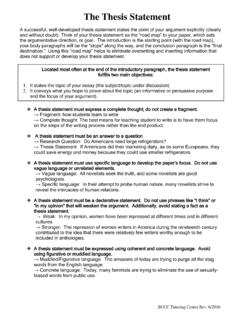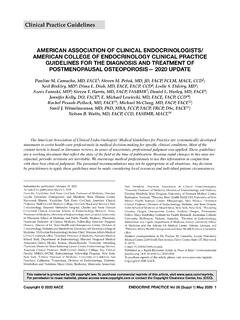Transcription of American Clinical Neurophysiology Society s Standardized ...
1 Downloadedfrom BhDMf5ePHKav1zEoum1tQfN4a+kJLhEZgbsIHo4 XMi0hCywCX1 AWnYQp/IlQrHD3i3D0 OdRyi7 TvSFl4Cf3VC4/OAVpDDa8 KKGKV0 Ymy+78=on 01/27/2021 Downloadedfrom BhDMf5ePHKav1zEoum1tQfN4a+kJLhEZgbsIHo4 XMi0hCywCX1 AWnYQp/IlQrHD3i3D0 OdRyi7 TvSFl4Cf3VC4/OAVpDDa8 KKGKV0 Ymy+78=on 01/27/2021 ACNS GUIDELINEA merican Clinical Neurophysiology Society s StandardizedCritical care EEG terminology : 2021 VersionLawrence J. Hirsch,* Michael Fong, Markus Leitinger, Suzette M. LaRoche, Sandor Beniczky,kNicholas S. Abend, Jong Woo Lee,# Courtney J. Wusthoff,** Cecil D. Hahn, M. Brandon Westover, Elizabeth E. Gerard, Susan T. Herman,kkHiba Arif Haider, Gamaleldin Osman, Andres Rodriguez-Ruiz, Carolina B. Maciel,## Emily J. Gilmore,* Andres Fernandez,** Eric S. Rosenthal, Jan Claassen, Aatif M. Husain, Ji Yeoun Yoo,kkkElson L. So, Peter W. Kaplan,### Marc R. Nuwer,** Michel vanPutten, Raoul Sutter, Frank W.
2 Drislane, Eugen Trinka, and Nicolas Gaspardkkkk*Comprehensive Epilepsy Center, Department of Neurology, Yale University School of Medicine, New Haven, Connecticut, ; Westmead ComprehensiveEpilepsy Unit, Westmead Hospital, University of Sydney, Sydney, Australia; Department of Neurology, Christian Doppler Klinik, Paracelsus Medical University,Salzburg, Austria; Department of Neurology, Emory University School of Medicine, Atlanta, Georgia, ;kDepartment of Clinical Neurophysiology , DanishEpilepsy Center, Dianalund and Aarhus University Hospital, Aarhus, Denmark; Departments of Neurology and Pediatrics, The Children s Hospital of Philadelphiaand the Perelman School of Medicine at the University of Pennsylvania, Philadelphia, Pennsylvania, ;#Brigham and Women s Hospital, Boston,Massachusetts, ;**Division of Child Neurology, Stanford University, Palo Alto, California, ; Division of Neurology, The Hospital for Sick Children, andDepartment of Pediatrics, University of Toronto, Toronto, Canada; Neurology Department, Massachusetts General Hospital, Massachusetts, ; Comprehensive Epilepsy Center, Department of Neurology, Northwestern University, Chicago, Illinois, ;kkBarrow Neurological Institute, Phoenix,Arizona, ; Department of Neurology, Henry Ford Hospital, Detroit, Michigan, ;##Division of Neurocritical care , Department of Neurology, Universityof Florida, Gainesville, Florida, ;**Department of Neurology, Thomas Jefferson University Hospital, Philadelphia, Pennsylvania, ; Department ofNeurology, Massachusetts General Hospital, Harvard Medical School, Boston, Massachusetts, ; Neurocritical care , Department of Neurology, ColumbiaUniversity, New York, New York.
3 Department of Medicine (Neurology), Duke University Medical Center, and Veterans Affairs Medical Center, Durham,North Carolina, ;kkkDepartment of Neurology, Icahn School of Medicine at Mount Sinai, New York, New York, ; Division of Epilepsy, Mayo Clinic,Rochester, Minnesota, ;###Department of Neurology, Johns Hopkins University School of Medicine, Johns Hopkins Bayview Medical Center, Baltimore,Maryland, ;**Department of Neurology, David Geffen School of Medicine at University of California Los Angeles, Los Angeles, California, ; Medisch Spectrum Twente and University of Twente, Enschede, The Netherlands; Medical Intensive care Units and Department of Neurology, UniversityHospital Basel, Basel, Switzerland; Department of Neurology, Harvard Medical School, and Comprehensive Epilepsy Center, Beth Israel Deaconess MedicalCenter, Boston, Massachusetts, ; andkkkkDepartment of Neurology, Universit Libre de Bruxelles, H^opital Erasme, Brussels, Belgium.
4 (J Clin Neurophysiol 2021;38: 1 29)INTRODUCTIONIn the early 2000s, a subcommittee of the American ClinicalNeurophysiology Society (ACNS) set out to standardize terminol-ogy of periodic and rhythmic EEG patterns in the critically ill to aidin future research involving such patterns. The initial proposedterminology was published in was presented at manymeetings on several continents,subjected to multiple rounds oftesting of interrater reliability, underwent many revisions, and wasthen published as an ACNS guideline in agreementof the 2012 version (published in early 2013) was very good, withalmost perfect agreement for seizures, main terms 1 and 2, the1 Smodifier, sharpness, absolute amplitude, frequency, and number was substantial for the1 Fand1 Rmodifiers(66% and 67%) but was only moderate for triphasic morphologyL. J. Hirsch received consultation fees from Aquestive, Ceribell, Marinus, Medtronic, Neuropace and UCB; received authorship royalties from Wolters Kluwer and Wiley;and received honoraria for speaking from Neuropace and Natus.
5 S. M. LaRoche received royalties from Demos/Springer Publishing. S. Beniczky is consultant for BrainSentinel & Epihunter and Philips; speaker for Eisai, UCB, GW Pharma, Natus, BIAL; and received research grants from Brain Sentinel, Philips, Eisai, UCB, GWPharma, Natus, BIAL, Epihunter, Eurostars (EU), Independent Research Fund Denmark, Filadelfia Research Foundation, Juhl Foundation, Hansen Foundation. N. received royalties from Demos; grants from PCORI and Epilepsy Foundation; and an institutional grant from UCB Pharma. J. W. Lee received grantsfromBioserenity, Teladoc, Epilepsy Foundation; is co-founder of Soterya Inc; is a board member of the American Clinical Neurophysiology Society ; does consulting forBiogen; and is site PI for Engage Therapeutics and NIH/NINDS R01-NS062092. C. J. Wustof does consulting for Persyst and PRA Health care . C. D. Hahn receivedgrants from Takeda Pharmaceuticals, UCB Pharma, Greenwich Biosciences.
6 M. B. Westover is co-founder of Beacon Biosignals. E. E. Gerard received grants fromGreenwich Pharmaceuticals, Xenon Pharmaceuticals, Sunovion, and Sage. S. T. Herman received grants from UCB Pharma, Neuropace, Sage. H. A. Haider receivesauthor royalties from UpToDate and Springer; does consulting for Ceribell, and is on advisory board for Eisai. A. Rodriguez-Ruiz is co-owner of RodziLLC which hasno relationship to this work. E. J. Gilmore received a grant from UCB Pharma. J. Claassen is a shareholder of iCE Neurosystems and received a grant from McDonnellFoundation. A, M. Husain received grants from UCB Pharma, Jazz Pharma, Biogen Idec; and received payment from Marinus Pharma, Eisai Pharma, NeurelisPharma,Blackthorn Pharma, Demos/Springer and Wolters Kluwer publishers. J. Y. Yoo received grants from NIH NeuroNEXT, Zimmer Biomet, LVIS; and receives authorroyalties from Elsevier. P. W. Kaplan receives author royalties from Demos and Wiley publishers; does consulting for Ceribell; and is expert witnessqEEG.
7 M. is a shareholder of Corticare. M. van Putten is co-founder of Clinical Science Systems. R. Sutter received grants from Swiss National Foundation(No320030_169379), and UCB Pharma. F. W. Drislane received a grant from American Academy of Neurology. E. Trinka discloses fees received from UCB, Eisai,Bial,B ohringer Ingelheim,Medtronic, Everpharma, GSK, Biogen, Takeda, Liva-Nova, Newbridge, Novartis, Sanofi, Sandoz, Sunovion, GW Pharmaceuticals, Marinus,Arvelle; grants from Austrian Science Fund (FWF), sterreichische Nationalbank, European Union, GSK, Biogen, Eisai, Novartis, Red Bull, Bayer, and UCB; otherfrom Neuroconsult , has been a trial investigator for Eisai, UCB, GSK, Pfitzer. The remaining authors have no funding or conflicts of interest to EEG examples are available online as supplemental digital content for this article. Direct URL citations appear in the printed text and are provided in the HTML andPDF versions of this article on the journal s Web site ( ).
8 Address correspondence and reprint requests to Lawrence J. Hirsch, MD, Department of Neurology, Comprehensive Epilepsy Center, Yale University School of Medicine, box 208018, New Haven, CT 06520, ; e-mail: 2020 by the American Clinical Neurophysiology SocietyISSN: 0736-0258/20/3801-0001 DOI by the American Clinical Neurophysiology Society . Unauthorized reproduction of this article is of Clinical NeurophysiologyVolume 38, Number 1, January 20211(58%) and fair for evolution (21%, likely at least partly because of theshort EEG samples provided).3 The authors concluded that interrateragreement for most terms in the ACNS critical care EEG terminologywas high and that these terms were suitable for multicenter researchon the Clinical significance of these critical care EEG the help of infrastructure funding from the AmericanEpilepsy Society and administrative and website support fromthe ACNS, a database that incorporated the ACNS terminologywas developed for Clinical and research purposes, tested duringroutine Clinical care in multiple centers,4and made available atno cost on the ACNS website ( ).
9 This greatly enhanced the ability tocomplete multicenter the establishment of the Standardized terminology andfree access to a database incorporating these terms, there have beenmany investigations into the Clinical significance of rhythmic andperiodic patterns (RPPs) in critically ill patients. Patterns such aslateralized rhythmicdelta activity (LRDA) were found to be highlyassociated with acute seizures,5,6equivalent to the association foundwith lateralized periodic discharges (LPDs) in one of all the main patterns in the nomenclature with seizureswas defined in a multicenter cohort of almost 5,000 patients, withseizure rates highest for LPDs, intermediate for LRDA andgeneralized periodic discharges (GPDs), and lowest for generalizedrhythmic delta activity (GRDA).6 This and other studies have shownthat several of the modifiers within the nomenclature do indeed haveclinically relevant meaning. For example, studies have shown thathigher frequency ( Hz)
10 , higher prevalence, longerduration, and having a plus modifier are all associated with ahigher chance of acute ,7On the other hand, whether apattern was spontaneous or stimulus-induced did not seem to havea significant effect on its association with otherinvestigations, the triphasic morphology modifier was investigatedblindly with multiple expert reviewers, calling into question itsrelationship with metabolic encephalopathy and its lack of arelationship with ,9 For patients with refractory statusepilepticus treated with anesthetic-induced coma, the presence of highly epileptiform bursts suggested that an attempted wean off ofanesthetics at that time was much more likely to lead to seizurerecurrence than if the bursts were not highly outcome seemed to be associated with some modifiers,with a higher risk of later epilepsy found if LPDs were moreprevalent, had longer duration, or had a plus IN THE 2021 VERSION OFTHE TERMINOLOGYA lthough the previous version of the terminology was easy touse, reliable, and valuable for both research and Clinical care , newterms and concepts have emerged.

